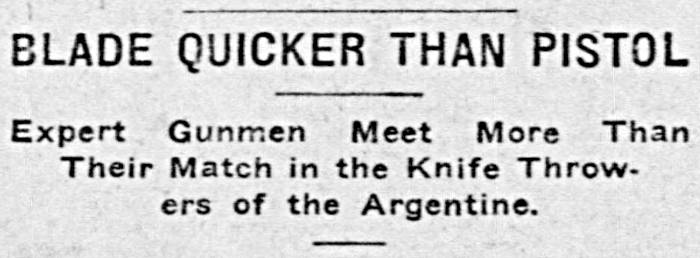 The danger zone encirclin a gaucho (cowboy of the Argentine) with his knife in his hand is by no means limited to the circle he sweeps with his extended arm. I am not sure just how far it does go, nor have I the least desire to find out. I heard, however, a crack revolver shot, a man who could blot out the spots on a ten of spades at a dozen paces, say that he would be extremely reluctant to take his chance at a draw-and-let-go with a gaucho at any distance under 20 yards.
The danger zone encirclin a gaucho (cowboy of the Argentine) with his knife in his hand is by no means limited to the circle he sweeps with his extended arm. I am not sure just how far it does go, nor have I the least desire to find out. I heard, however, a crack revolver shot, a man who could blot out the spots on a ten of spades at a dozen paces, say that he would be extremely reluctant to take his chance at a draw-and-let-go with a gaucho at any distance under 20 yards.
An illuminative case In point came to my attention in Buenos Aires. As a class the American agricultural machinery experts sent to Argentina are as handy with sixshooters as any I have ever met. They are mostly westerners, have used revolvers from their childhood, and their arms, from which they never separate themselves for a moment while in campo, are always of the best and latest pattern.
Not once or twice, but on dozens of occasions, have I seen one or another of these men with his Colt’s or Mauser “automatic,” after a preliminary shot or two to get the range blow over a rabbit running at full speed across the pampa. This is good shooting, as will be appreciated by anyone who has had experience with the revolver. Yet the case I have In mind is that of a thrashing machine expert from Texas — a crack shot — who had trouble with his Argentine maquinista, had an even break on a draw at 25 or 30 feet, and was retired from action with a knife through his shoulder before his revolver was clear of its holster.
Lewis R. Freeman in the Cornhill Magazine.
The Aberdeen Weekly. Aberdeen, Miss, March 11, 1921